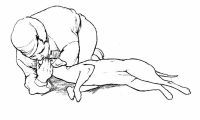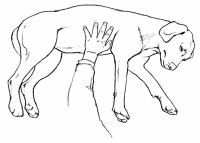Quck answer
Giving first aid to your dog is crucial in emergency situations. Here are some basic steps to follow:
1. Stay calm and assess the situation.
2. Control any bleeding by applying pressure to the wound.
3. Check for breathing and pulse. If necessary, perform CPR or artificial respiration.
4. Protect your dog’s spine and neck in case of suspected injury.
5. Treat for shock by keeping your dog warm and calm.
6. Transport your dog to the veterinarian as soon as possible.
7. Keep a first aid kit handy that includes items such as bandages, scissors, and antiseptic solution.
Remember, administering first aid is not a substitute for professional veterinary care. Always seek the advice of a veterinarian after performing first aid on your dog.
Pets
How to Treat a Dog That Has Inhaled Smoke or Carbon Monoxide

В©2006 Publications International, Ltd. Step 2
Dogs can be threatened by fires. However, it is not recommended to risk your own life to save your pet. Leave this task to firefighters or trained individuals in rescue operations.
If a dog has inhaled smoke or carbon monoxide, it may display symptoms such as depression, lack of coordination, heavy panting, deep red gums, and possible convulsions. Watch out for signs of shock such as pale or white gums, rapid heartbeat, or rapid breathing.
If you suspect your dog is suffering from smoke or carbon monoxide inhalation, follow these tips to provide the appropriate care:
If the Dog is Conscious
Step 1: Remove the dog from the area and take it to an area with fresh air immediately.
Step 2: Rinse the dog’s eyes thoroughly with saline solution or clean water.
Step 3: Take the dog to the vet as soon as possible.
If the Dog is Unconscious
Step 1: Remove the dog from the area and take it to an area with fresh air immediately.
Step 2: If the dog is not breathing, check for a heartbeat by placing your fingers approximately 2 inches behind the dog’s elbow in the middle of its chest.

В©2006 Publication International, Ltd. Step 2
Step 3: If there is no heartbeat, proceed to Step 4. If there is a heartbeat, perform artificial respiration.
Step 3a: Turn the dog on its side.
Step 3b: Hold the dog’s mouth and lips closed and blow into its nostrils firmly. Administer one breath every 3 to 5 seconds. Take a deep breath and repeat until you feel resistance or notice the dog’s chest rise.
Step 3c: After one minute, stop and observe the dog’s chest for any signs of breathing movement.
Step 3d: If the dog is not breathing, continue performing artificial respiration.
Step 4: If there is no heartbeat, perform cardiopulmonary resuscitation (CPR).
CPR for Dogs Weighing up to 45 Pounds
Step 4a: Turn the dog on its back.
Step 4b: Kneel down at the dog’s head.
Step 4c: Place your hands on the dog’s chest with your palms resting on either side of its chest.

В©2006 Publications International, Ltd. Step 4e
Step 4d: Press firmly on the chest with your palms for a count of “2” and release for a count of “1.” Repeat this about 60 to 90 times per minute with moderate pressure.
Step 4e: After 30 seconds, blow into the dog’s nostrils by holding its mouth and lips closed. Blow for three seconds, take a deep breath, and repeat until you feel resistance or see the dog’s chest rise. Try to repeat this 10 to 20 times per minute. As a general rule, use a CPR ratio of about 5 heart compressions to 1 breath of air.
Step 4f: After one minute, stop and observe the dog’s chest for any signs of breathing movement. Check for a heartbeat by placing your fingers approximately 2 inches behind the dog’s elbow in the middle of its chest.
Step 4g: If the dog’s heart is not beating, continue performing CPR. If the heart starts beating, but the dog is still not breathing, return to Step 3.
CPR for Dogs Weighing More Than 45 Pounds
Step 4a: Turn the dog on its side.

В©2006 Publications International, Ltd. Step 4b
To perform CPR on a dog, place your hand’s palm in the middle of the dog’s chest and press for a count of “2,” and release for a count of “1.” It is necessary to apply firm pressure. Repeat this process about 60 to 90 times per minute.
After 30 seconds, hold the dog’s mouth and lips firmly closed and blow into its nostrils. Blow for 3 seconds, take a deep breath, and repeat until you feel resistance or see the chest rise. Try to repeat this process 10 to 20 times per minute.
After 1 minute, check the chest for breathing movement and feel for a heartbeat by placing your fingers about 2 inches behind the dog’s elbow in the center of its chest.
If the dog’s heart is not beating, continue CPR. If the heart starts beating but the dog is still not breathing, go back to Step 3.
Transport the dog immediately to the veterinarian. CPR or artificial respiration should be continued on the way to the veterinarian or until the dog is breathing and its heart is beating without assistance.
In case of a puncture wound, dogs can experience pain and trauma. In the following section, we will learn how to treat this type of injury.
FAQ
1. What should I do if my dog is choking?
If your dog is choking, you should first try to remove the object that is causing the obstruction. If it is visible and can be safely removed, gently take it out. If the object is not visible or cannot be removed, you should perform the Heimlich maneuver on your dog. To do this, stand behind your dog and put your hands around its chest just behind the rib cage. Apply firm pressure to squeeze the air out of the lungs and push the object out. If the dog is still choking, take it to the vet immediately.
2. How do I stop my dog’s bleeding?
If your dog is bleeding, you should first apply gentle pressure to the wound with a clean cloth or bandage. If the bleeding is severe, elevate the wounded area above the level of the heart to help slow the flow of blood. If the wound is deep or has an object lodged in it, do not remove the object. Instead, take your dog to the vet immediately.
3. How do I treat a dog with a broken bone?
If you suspect that your dog has a broken bone, you should immobilize the affected area by wrapping it in a towel or bandage. Take your dog to the vet immediately for an X-ray and proper treatment. Do not attempt to set the bone yourself as this can cause more harm than good.
4. What should I do if my dog has a seizure?
If your dog is having a seizure, remove any objects that could cause injury and gently hold your dog to prevent it from hurting itself. Do not put anything in its mouth. Time the seizure and take notes on its duration and symptoms. Once the seizure has ended, take your dog to the vet for an examination and treatment.
5. What should I do if my dog has a heat stroke?
If your dog is suffering from a heat stroke, you should move it to a cool area and apply cool water to its fur and skin. Offer the dog cool water to drink and take it to the vet immediately. Heat stroke can be deadly, so it is important to act quickly.
6. How do I treat a dog with a bee sting?
If your dog has been stung by a bee, remove the stinger by scraping it out with a credit card or similar object. Apply a cold compress to the area to reduce swelling and pain. If your dog is having an allergic reaction, take it to the vet immediately.
7. What should I do if my dog ingests something toxic?
If your dog ingests something toxic, call the ASPCA Animal Poison Control Center at (888) 426-4435 immediately. They will provide you with instructions on what to do next. Do not induce vomiting unless instructed to do so by a professional.
8. How do I treat a dog with a cut or wound?
If your dog has a cut or wound, clean the area with warm water and a mild soap. Apply an antibiotic ointment and cover the wound with a clean bandage. Check the wound daily for signs of infection. If the wound is deep or has an object lodged in it, take your dog to the vet immediately.
9. What should I do if my dog is having trouble breathing?
If your dog is having trouble breathing, check its airway for obstructions. If there is an object blocking the airway, remove it if possible. If your dog is still having trouble breathing, take it to the vet immediately.
10. How do I treat a dog with a burn?
If your dog has a burn, apply cool water to the affected area to reduce pain and swelling. Cover the burn with a clean, damp cloth and take your dog to the vet immediately. Do not apply ointments or creams to the burn.
11. What should I do if my dog is hit by a car?
If your dog is hit by a car, approach it slowly and calmly to avoid causing further injury. Carefully lift your dog onto a flat surface, such as a board or blanket. Check for signs of breathing and heartbeat. If your dog is not breathing or has no heartbeat, perform CPR. Take your dog to the vet immediately for emergency treatment.





Leave a Reply